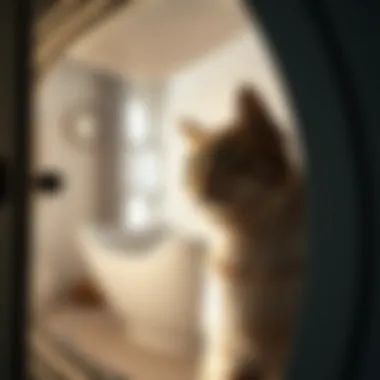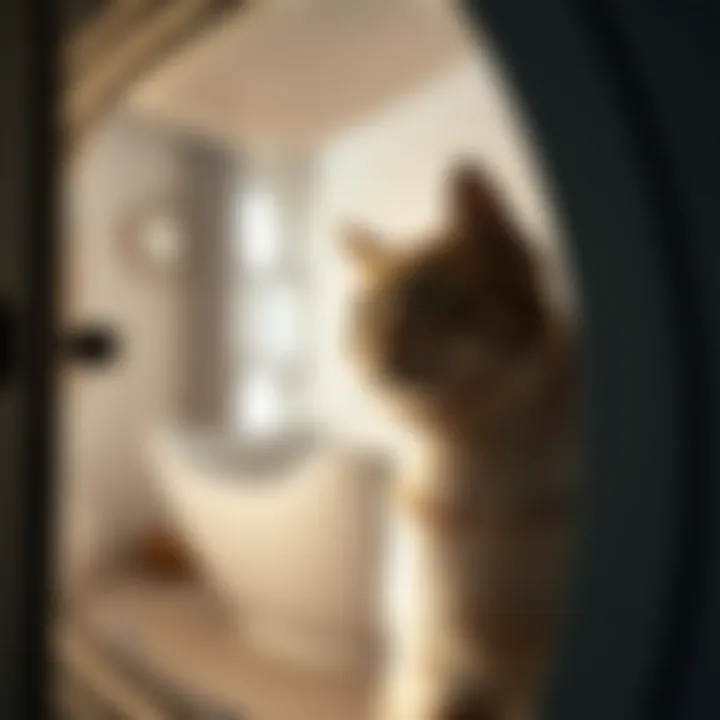Removing Cat Urine Stains: Effective Strategies


Intro
Understanding the Challenge
Before we jump into solutions, it's important to grasp the chemistry behind cat urine. When cats urinate, their waste contains uric acid, which is notorious for its persistence. Simply washing the fabric might not be enough, as this compound can remain in the fibers long after the visible stain has gone. Furthermore, certain cleaning products only mask the odor without neutralizing it. Knowing this can change your approach entirely.
Consulting such scientific insights allow for a more informed cleaning methodology.
Importance of Prompt Action
Timing is crucial. The longer you let cat urine set, the harder it becomes to eliminate both the stain and the smell. If you catch it while it’s still fresh, you'll have an easier time managing the problem. Some basic steps can make a world of difference:
- Blot the area: Quickly use a clean cloth to soak up as much liquid as possible. Avoid rubbing, as this can spread the liquid further into the fabric.
- Rinse with cold water: This can dilute the urine and help flush out the acid before it has a chance to bond with the fibers.
"Timely action often leads to successful outcomes—both in life and laundry."
The Right Cleaning Products
Now you might wonder, what exactly should I be using to combat this stubborn foe? When selecting a cleaning product, look for enzymatic cleaners, which are designed specifically to break down uric acid. Popular options include:
- Nature’s Miracle: Known for its powerful formula that effectively eliminates stains and odors.
- Rocco & Roxie Supply Co.: Another highly-rated product that neutralizes cat pee without harsh chemicals.
- Clorox Urine Remover: This combines ammonia with special enzymes for extra effectiveness.
When applying these products, follow the instructions closely to achieve optimal results.
Application Techniques
Understanding how to apply these products is nearly as important as selecting the right one. Here’s a simplified guide:
- Pre-treat the stain: Apply your chosen cleaner directly onto the stain. Let it sit for at least 10 minutes.
- Soak or wash: Depending on the severity, either soak the garment in a solution of water mixed with the cleaner or run it through a wash cycle. Remember to use cold water.
- Repeat if necessary: Sometimes stains are stubborn. Don’t hesitate to repeat the process.
By following these steps, you’re setting yourself up for success.
End
Tackling cat urine stains in laundry doesn’t have to feel like an uphill battle. With a bit of knowledge and the right products, you can restore the freshness of your garments and keep your laundry smelling clean. Remember, the key lies in understanding the chemistry of the problem, acting promptly, and employing effective cleaning solutions. This guide aims to empower you, making it easier to resolve this common issue and maintain a pleasant home.
For further reading on effective stain removal techniques, you can check out Wikipedia or visit Britannica. Explore forums on Reddit to share experiences and gather tips from fellow pet owners.
Prologue to the Problem of Cat Urine in Laundry
Dealing with cat urine in laundry is an issue that many pet owners face. The presence of a feline household companion often comes with unexpected challenges, chief among them the unwelcome and lasting stains of cat urine. This article aims to shed light on the importance of addressing this problem effectively—not just for the sake of aesthetics but also for the health and comfort of your home.
The pungent nature of cat urine can turn a simple laundry task into a frustrating experience. Beyond mere aesthetics, odors can foreshadow underlying hygiene concerns. Keeping your laundry free from such odors is essential for creating a welcoming environment and ensuring that garments remain in good condition. Without proper action, cat urine can contribute to the degradation of your fabric materials and even lead to a more significant cost when it comes to replacing items.
In the subsequent sections, we will explore various aspects that fall under this umbrella—from the chemical makeup of cat urine to why it wields a strong odor and what effective strategies can be employed for removal.
Understanding Cat Urine Composition


Cat urine is a unique concoction that encompasses a variety of compounds. Unlike other animal urine, cat urine contains a high concentration of urea, uric acid, and specific proteins. When a cat’s urine is left untreated, the uric acid can crystallize and bond with fabrics, making it particularly difficult to remove. This chemical tenacity is what sets cat urine apart from other household stains.
Additionally, the presence of various waste products and hormones in cat urine can lead to its characteristic strong scent. If not dealt with promptly, these compounds can seep into the fibers of clothing and linens. The longer the urine remains, the more challenging it becomes to eradicate the smell.
The Role of Uric Acid
Uric acid plays a significant role in the challenge of cleaning up after cats. When cat urine dries, the uric acid can form crystals. Even after washing, these crystals may remain hidden in fabric fibers, continuing to release odors when exposed to humidity or heat. This unfortunate phenomenon explains why some fabrics retain their unpleasant scent long after they have been laundered.
Why Cat Urine Leaves Lasting Odors
The powerful odor of cat urine can be attributed to the volatile compounds it contains. When a cat pees, not only does it release a pungent scent that serves as a territorial marker, but it simultaneously distributes ammonia—a compound notorious for its strong fragrance and potential health hazards when inhaled in large quantities. This poses a dual challenge: the stain is one aspect, but the odor lingers as another dilemma.
Chemical Breakdown of Odor
The chemical breakdown of cat urine produces byproducts such as thiols, which can impart an unpleasant and persistently lingering aroma. These substances have a way of embedding themselves within porous materials, such as fabrics, making casual cleaning insufficient. It becomes clear that proper treatment solutions are vital not just for visual cleanliness but for a genuinely fresh-smelling space.
Cat owners need to recognize that quick fixes may not suffice; understanding the underlying chemistry of cat urine aids in implementing effective strategies for removal.
As we continue this guide, consider how the biological makeup of cat urine impacts your cleaning approach. The unique challenges it presents warrant attention to detail and a willingness to employ both traditional and novel methods of removal. As we explore practical cleaning supplies in the upcoming sections, keep these insights in mind—they may make all the difference in restoring your laundry to its original state.
Initial Steps for Handling Stained Laundry
When faced with the unpleasant surprise of cat urine on your laundry, the initial steps you take can significantly affect the outcome of your cleaning efforts. The importance of addressing the problem quickly cannot be overstated. Cat urine, if left untreated, can not only lead to permanent stains but also create stubborn odors that can linger for a long time, rendering your laundry less than fresh. By understanding the initial steps, you are setting yourself up to tackle this issue head-on, ensuring your garments come out smelling clean and looking good as new.
Acting Quickly: Why Timing Matters
Timing is everything in life, and when it comes to cat urine, it’s no different. The sooner you act, the better your chances are of removing the stain and odor. Fresh stains are much easier to deal with compared to those that have had time to set in. A cat's urine contains urea, which can break down into ammonia over time, intensifying both the color and the smell.
- Immediate Action: If you catch the stain right away, blot the area with paper towels or a cloth. This prevents the urine from soaking deeper into the fabric.
- Avoid Rubbing: Rubbing might seem like a good idea to remove the stain, but it can actually work the liquid further into the material. Stay gentle—dab instead.
- Wash Promptly: As a rule of thumb, ensure your stained laundry is washed within 24 hours. Leaving it longer opens the door for more complex cleaning challenges.
"A stitch in time saves nine"—this old saying fits the bill perfectly when dealing with stains. The quicker you act, the less trouble you'll have in the long run.
Assessing the Damage: Stain and Odor Severity
Once you’ve acted quickly, it’s crucial to assess the extent of the stain and odor. Determining severity will inform your cleaning strategy effectively. Not all stains are created equal, and understanding what you’re dealing with can save you precious time and resources.
- Visual Inspection: Look closely at the stained area. Is it a light spot, or does it show a darker, more intense coloration? This can help gauge how long it’s been there.
- Smell Test: Sometimes, it’s not just about what you see, but what you can smell. If there is a strong, pungent scent, it’s an indicator of a deeper problem.
- Fabric Type Consideration: Some fabrics are more absorbent than others. For instance, cotton and wool tend to soak up liquids more efficiently than synthetic materials. Knowing your fabric type can influence your choice of cleaning agents.
In summary, by acting promptly and accurately assessing the damage, you're laying a solid foundation for effective cleaning. This proactive approach ensures your efforts yield the best possible results, saving you both time and stress in the long run.
Assessment of Cleaning Supplies
When faced with the challenge of removing cat urine from laundry, selecting the right cleaning supplies can make or break your efforts. Not all cleaners are created equal, and understanding the various options available can save you time, money, and frustration. This section aims to equip homeowners and pet owners with the knowledge needed to choose effective products that can tackle those stubborn stains and odors.
Enzymatic Cleaners: How They Work
Enzymatic cleaners are specifically designed to break down the complex organic compounds found in cat urine. These cleaners contain natural enzymes that target the proteins, uric acid, and urea responsible for the unpleasant odors and stains. The beauty of these products lies in their biological action; they effectively digest the bacteria present in urine, leading to complete odor elimination rather than merely masking it.


Using enzymatic cleaners is akin to calling in the reinforcements; they dismantle the problem at its molecular level. For optimal results, it's generally recommended to:
- Apply generously: Coverage is key. Ensure that the affected area is saturated to allow the enzymes to work effectively.
- Let it sit: Allow the cleaner to dwell for a sufficient time, usually 10 to 30 minutes, depending on the product.
- Rinse thoroughly: After treatment, rinse the area well to remove any residues, allowing the area to breathe.
Recognizing reputable brands such as Nature's Miracle or Simple Solution can help streamline your selection process, as their offerings have been well-reviewed by many users.
Household Alternatives: Baking Soda and Vinegar
For those looking for a budget-friendly or natural solution, household staples like baking soda and vinegar can be surprisingly effective. Baking soda acts as a deodorizer, absorbing odors rather than covering them up. When paired with vinegar, which has strong antimicrobial properties due to its acidity, they create a formidable duo against cat urine stains.
To utilize this method:
- Clean the area first: Blot the stain with a cloth to remove excess liquid.
- Sprinkle baking soda: Cover the stained area generously with baking soda and let it sit for a few hours or overnight.
- Mix a solution: Combine equal parts vinegar and water in a spray bottle, then gently spray the area where the baking soda has been. A bubbling reaction will occur, which helps lift the stain.
- Scrub gently: After a few minutes, use a clean cloth to scrub the area, and then rinse with water.
This method not only works well but is also safe for most fabrics and environments, making it an appealing choice for many.
Commercial Products: A Review of Effectiveness
There are countless commercial products available for tackling the aftermath of feline accidents. These products vary significantly in formulation, scent, and effectiveness. Therefore, choosing the right one requires a little research and consideration. Look for products that are labeled specifically for pet urine removal, as these are tailored to address the unique challenges of this particular issue.
A helpful approach is to look for:
- Consumer Reviews: Look at feedback from other pet owners to see what worked and what didn’t. Websites like Reddit or Amazon often contain real-world testimonials.
- Ingredients: Products with enzymatic formulas tend to fare better than those with just basic soap formulations. Caution about harsh chemical cleaners is advisable as these can sometimes make odors worse or irritate sensitive fabrics.
- Trial Sizes: If undecided, consider purchasing smaller bottles first to assess effectiveness before committing to larger quantities.
"Choosing the right cleaning supplies is more than just a task; it’s a vital step to reclaiming your space from unwelcome odors and stains."
For more resources on cleaning supplies and pet care: Wikipedia Pet Urine Cleaners, Britannica on Odor Removal, Reddit Discussions on Pet Care.
Step-by-Step Guide to Treatment
When it comes to tackling cat urine stains in laundry, a methodical approach can make all the difference. This section is vital because it not only guides you through the cleaning process but also helps you understand the rationale behind each step. Following a structured method allows you to effectively eliminate odors while preserving the integrity of your fabrics. By breaking down the treatment into clear stages, you’ll gain confidence, ensuring you don’t miss any critical actions.
Pre-treating Stains: Application Techniques
Pre-treatment is like arming yourself before heading into battle. This initial step is essential for successfully breaking down the uric acid crystals found in cat urine, which can cling to fibers even after washing. Here’s how to do it:
- Identify the Stain: Locate the area affected. If you can still smell the urine, your odds are good that it’s stained.
- Choose Your Cleaner: Whether you opt for an enzymatic cleaner or a home remedy like a mixture of water and vinegar, having your cleaning solution ready is crucial.
- Apply Generously: Spray or pour the cleaner onto the stained area. Ensure you cover the entire spot, allowing it to soak into the fabric.
- Let it Sit: Give the solution time to work—typically around 15 to 30 minutes. This way, the enzymes can break down the stain properly.
It’s wise to test any cleaner on an inconspicuous area first to avoid damage. Always follow the manufacturer's instructions for optimal results.
Washing Methods: Effective Cycle Selection
Choosing the right washing cycle can significantly influence the outcome of your laundry. Both the temperature and the cycle duration can help in removing any remnants of the cat urine effectively. Here are key considerations:
- Select the Right Temperature: Hot water is generally better at breaking down stains, though you must consider your laundry’s fabric care labels. Check if high heat is appropriate first.
- Adjust Cycle Length: A longer wash cycle will usually yield better results for heavily stained fabrics as it provides the detergent with ample time.
- Include an Extra Rinse: Adding an extra rinse cycle can help flush out remaining cleaners and odors.
Be mindful to load the washing machine correctly; don’t overcrowd it. If your cat has left several items soaking in trouble, it’s best to wash them in batches for effective cleaning.


Post-Treatment Evaluation: Identifying Success
After washing, it’s crucial to assess the success of your treatment. Here are some methods to ensure that the odors and stains are gone:
- Smell Test: This may seem intuitive, but it’s often the most telling sign. If you can still detect a hint of odor, further treatment may be needed.
- Visual Inspection: Check the stained area under good lighting to see if any discoloration or residue remains.
- Feel the Fabric: Sometimes stains can feel different. The fabric should feel clean and fresh to the touch.
If the results are not satisfactory, don’t lose heart. You can repeat the stain treatment steps as necessary. Moreover, patience here is key—some odors and stains are particularly stubborn.
Once the cat urine stains are treated successfully, you’ve not only saved your laundry but also regained peace of mind.
For more extensive resources, consider visiting Wikipedia for cleaning tips or exploring discussions on Reddit regarding pet care.
In summary, taking a strategic approach to the treatment of cat urine stains in laundry can help manage the issue more effectively, empowering homeowners and pet owners alike. Following these steps ensures that your laundry remains fresh and odor-free.
Long-term Prevention Strategies
To effectively tackle the issue of cat urine in laundry, a proactive approach is necessary. Preventing incidents from occurring in the first place not only alleviates the stress of dealing with unpleasant odors and stains but also promotes a harmonious living environment for both you and your feline companion. By adopting consistent long-term prevention strategies, you significantly reduce the chances of future problems. This section delves into both behavioral modifications for your cat and maintaining a clean environment through proper litter box management.
Behavioral Modifications for Cats
Understanding cat behavior is key to preventing accidents in the first place. Cats are creatures of habit, and by modifying certain behaviors, you can keep them from urinating outside their designated areas. Here are some actionable steps to consider:
- Provide Choice: Cats are pickier than you might think. Offering various types of litter can help. Your feline might prefer finer grains or natural options over clumping, for example. Take note of what they gravitate towards.
- Nurture Positive Associations: Encourage your cat to use the litter box by rewarding them with treats or praise after a successful visit. Create a relaxing atmosphere by minimizing noise and disturbances near the litter area.
- Monitor Stress Levels: Cats can be sensitive to changes in their environment. Whether it's a new pet, guests in the home, or changes in household routines, observe how your cat reacts. Providing a safe space with familiar items can help them feel secure.
- Regular Playtime: Engaging your cat in daily play can reduce stress and prevent unwanted behaviors, such as marking territory. Make sure to schedule play sessions that keep their mind and body stimulated, lessening any urge to misbehave.
"A happy cat is a well-behaved cat, so invest time to bond and understand them better."
Maintaining a Clean Environment: Litter Box Management
One of the most crucial aspects of long-term prevention is effective litter box management. A clean and accessible litter box is vital for your cat’s comfort and willingness to use it. Here are some important considerations:
- Location Matters: Keep the litter box in a quiet, easily accessible area. Avoid placing it near their feeding station or in high-traffic zones. Cats prefer a bit of privacy.
- Regular Cleaning Routine: Scoop the litter daily and change it entirely on a weekly basis. This not only helps with odor control, but ensures your cat feels inclined to use it. Consider using a high-quality clumping litter for easier maintenance.
- Multiple Boxes: If you have more than one cat, it’s a good idea to have multiple litter boxes—ideally, one for each cat plus one extra. This reduces potential territorial disputes and accidents.
- Consider a Covered Box: Some cats prefer the privacy of a covered litter box. However, it’s essential to ensure good ventilation to prevent odors from building up inside.
By taking these steps, not only can you impact your cat's behavior positively, but you'll also contribute to a more pleasant living environment. It’s about creating a culture of cleanliness and comfort that allows your cat to thrive, all while keeping your laundry fresh and odor-free.
Ending: Moving Beyond Stains and Odors
Dealing with cat urine in laundry can feel like a tempest in a teapot, but understanding and confronting this issue can lead to a more harmonious home. The final thoughts on this subject underscore not only the need for effective stain removal techniques but also the broader importance of creating a fresh and welcoming environment. Having a solid grasp on the composition of cat urine is enlightening—this knowledge translates directly into more successful cleaning strategies.
When you tackle the stains and odors head-on, you take back control over your living space. Every step you take towards removing those pesky odors fosters an atmosphere that you can be proud of. Many homeowners underestimate how critical a fresh laundry space truly is. It acts as a sanctuary, not just for clothes, but for your overall well-being. A cleaner environment can promote better mental health and boost comfort at home.
Additionally, consider the long-term ramifications of your cleaning efforts. Regularly addressing stains keeps your laundry area not just clean, but also reduces the likelihood of those odors resurfacing in the future. It reinforces the concept that maintenance is key; by developing good habits and employing effective cleaning strategies, you can enjoy a space that is both functional and inviting.
"A fresh laundry space isn't merely about aesthetics; it’s a fundamental part of home comfort."
In summary, moving beyond stains and odors is essential not just for the sake of cleanliness, but for cultivating a space that fosters happiness and tranquility. Let's look at the nuances further with the next section.
The Importance of a Fresh Laundry Space
The laundry area plays a pivotal role in the household. It's often the backdrop to routines and rituals that, while mundane, hold significant importance in our lives. A fresh laundry space goes beyond the mere act of cleanliness. It encompasses an emotional dimension that promotes relaxation and peace of mind.
To achieve this, regular cleaning and maintenance of this space are non-negotiable. Here are some elements that contribute to minimizing odors:
- Frequent cleaning: Simple tasks like wiping down surfaces and cleaning out lint traps can make a world of difference.
- Adequate ventilation: Ensuring that your laundry area is well-ventilated reduces moisture build-up, which can lead to unpleasant smells.
- Organizational strategies: Keeping detergents, fabric softeners, and other supplies neatly stored can help maintain a pleasant environment. It reduces clutter, allowing for a sense of order.
Establishing a routine that integrates these practices will not only enhance the fragrance of your laundry but will also contribute positively to your overall perception of home cleanliness. In essence, a fresh laundry space fosters a myriad of benefits that extend from the tangible to the emotional, enhancing your quality of life. By taking proactive measures, you ensure that your laundry experience is one of satisfaction rather than frustration.















